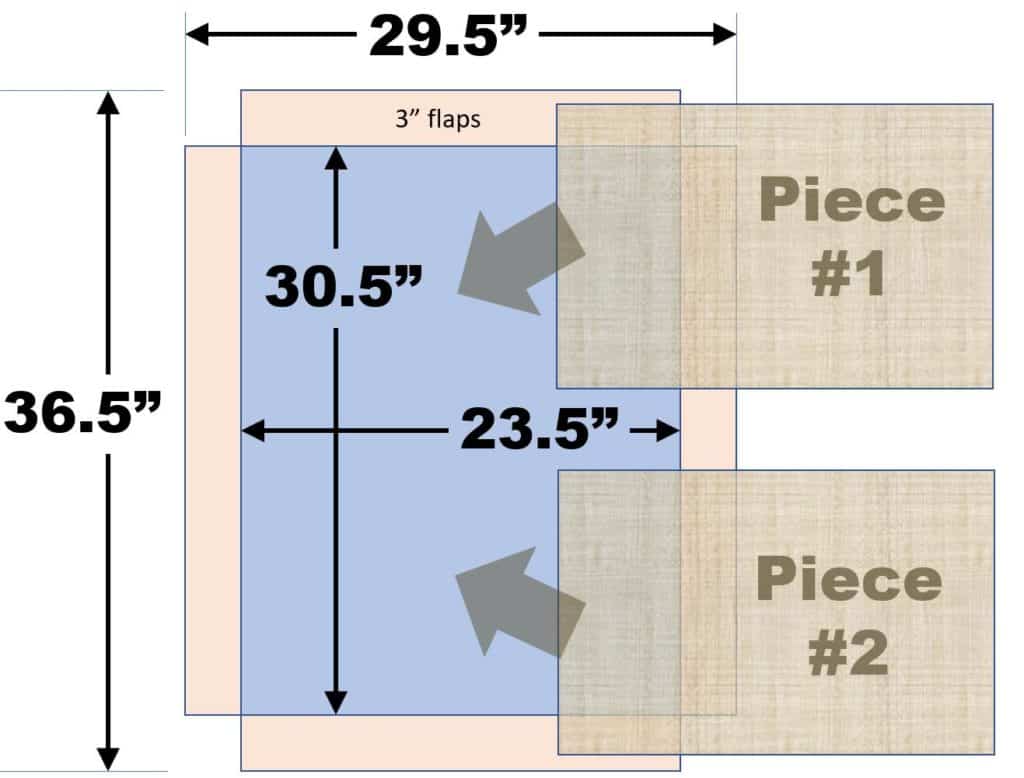Understanding Soundproofing is Simple
Just want to do it yourself? Check out the instructions!
Ever watch piles of large, sharp rocks on a shoreline break up the waves coming in? Acoustic baffles (foam panels, wool or fiberglass batts or panels) dampen sound in a similar way.
The rocks “break up” the wave to reduce its force. Acoustic foam is porous inside (like Swiss cheese)—kind of like a giant box of sharp rocks! The sound bounces through all the air “tunnels” between the sharp rocks, reducing its energy.
And more is better! You needs a long maze of air spaces inside the foam for the sound to bounce around in and lose energy.
But a wave will just flow over a pile of smooth stones, so the rocks need to be sharp, and in acoustic foam that means lots and lots of tiny, sharp-edged airspaces.
Solid material doesn’t work well. It mostly blocks and reflects sound instead of trapping it. You don’t want the sound bouncing back, you want to trap it inside the material and reduce it.
But you do need something solid enough to resist the waves. For water waves, piles of shredded plastic would just flow with the waves! Rocks resist the waves.
This is why cheap foam not made for soundproofing (such as that used in egg crates) doesn’t dampen sound well: it’s not firm enough. Air is a gas. Sound is a wave that moves through that gas, similar to wind, only sound is more like the water wave. The internal cell walls of cheap foam vibrate with the sound too much instead of resisting it sufficiently. You don’t want material that just ripples like ribbons in the wind!
You get an immediate improvement from acoustic dampening materials if you place them at right angles to each other, since the sound will bounce from one to the other. Aiming sound into a “V” shape is the most basic acoustic “trap”. This is why foam for acoustic dampening has a zig-zag or “egg crate” pattern in it. Besides the maze inside the foam that helps trap the acoustic wave, it forces it to bounce around as it enters the maze as well.
Batts vs Panels vs Blankets vs Fibers.
Most articles on studio acoustics are about dampening non-bass sound frequency and energies, and the common material choices are batts, panels, blankets, or fibers. (Bass dampening strategies are covered later in this article.) These are the materials that will create the “maze” you need to trap and quiet (dampen the acoustic energy of) sound waves.
The goal is to quiet sound inside the room, not outside the room. Measuring how much quieter it is inside the room is usually done in NRC. Measuring how much quieter it is outside the room is usually done in STC—simply put, it measures how much sound a wall, for instance, will block from getting through the other side. Unless you’re trying to block out loud noise outside the room, ignore STC measurements, and ignore STC products such as Mass Loaded Vinyl and other materials that promote their STC measurements.
NRC, or Noise Reduction Coefficient is an average rating of how much sound an acoustic product can absorb—how much quieter a product can make your space. Generally you want ratings higher than .75—the higher the number, the more sound that material absorbs.
What to buy:
Buying used towels or shredded clothes and bunching them together with chicken wire or something similar will usually be the cheapest approach. The next best deal is acoustic batt (flexible wall insulation) materials (available at most home improvement stores) such as Rockwool Safe’N’Sound (buy here at Lowe’s), Johns Manville SAFB/Sound and Fire Block, or Thermafiber (Owens Corning). Acoustic blankets are next most expensive (along with solid wall insulation, e.g. Corning 703), and lastly, panels made of acoustic foam are (generally) the most expensive way (meaning: avoid) to achieve effective sound deadening/absorbing/quieting. Most smart studios buy acoustic wall insulation, put it in frames and wrap it in fabric to get the quietest studio space at the lowest cost.
Why Bass Frequencies “Pool” in corners
Generally, as a material’s thickness is doubled, whatever absorption it has at a given frequency is extended to an octave lower. Since it would take a lot of thickness to effectively dampen some of the lowest common (“bass”) audible frequencies, other strategies than just using thicker materials are used to deal with bass frequencies.
But in most home studios, absorbing bass frequencies is NOT a priority. Avoiding too-small spaces and putting a cheap bass trap behind the mic is usually all that is needed. However, here’s how to understand and deal with bass frequency dampening:
Drop a large rock in the center of a square pond and a circular ripple will hit the four shores at the same time and spread out until it hits the corners. Picture the corner. Two shores of the pond connect to it. On each of those shores a wave hits, then spreads toward the corner. So you have two walls each sending a ripple toward the corner. Now picture rubber ducks bobbing up and down. Where do you think the ducks will bounce up and down the most? That’s right, the corners, because each corner has those two walls sending a pressure ripple into it.
Sound is like continuously dropping rocks into the pond—a continuous source of ripples heading for the walls. But a room is not a flat pond. Each corner has THREE flat surfaces sending ripples to it—two walls and the ceiling for upper corners, or two walls and the floor for lower corners.
Of all acoustic frequencies from high to low, the lowest frequencies (bass) behave the most like the waves in the pond. So corners of rooms tend to “pool” bass frequencies in them, where all the ripples are bumping into each other. And because lower frequencies have longer wavelengths, thin wave dampeners have less effect. You need THICKER material to affect bass frequencies.
The Bag of Laundry Trick
So to limit bass frequencies from causing sounds you don’t want, a minimum strategy is:
- Material at least 3 feet thick;
- Material placed in corners where bass frequencies “pool”.
So: yup, if you hang big bags of crumpled laundry in every corner of a room, you’ve created great bass traps! Picture a “cube” of air in each corner that is 3 feet square. This is the area that needs the most work.
The smaller the space, the tougher it is to control bass frequencies, due to their long wavelengths.
The most effective method for dampening bass frequencies is the “tube trap” (that you can make yourself) to better attenuate bass frequencies. There are a variety of DIY guides. Kits are also available. Tube traps can be used in a variety of configurations. There are also meta materials being researched.
Tiny Voiceover “Booths” Are Not Ideal
If you are listening to sound where your ear is far from the speaker, like a home theater space, bass traps are very important to normalizing the sound. It’s most important in smaller spaces—those 2-3 foot corner spaces make up practically the whole room in a 6x6x6 space! This is just one reason that small voiceover “booths” with parallel sides don’t always work well. But in large rooms bass pooling doesn’t affect the sound as much.
A bit of an exception is a walk-in closet that is completely filled with clothes. All those clothes are great sound dampening, and opposing racks of clothes are thick enough in total to help dampen bass frequencies as well as higher frequencies.
Also, if the “ear” is very close to the sound source, bass pools will have less effect on what you hear. If you are recording voiceover, your voice is the sound source, and the “ear” is the microphone, just inches away. So bass traps matter much less for voiceover than for a home theater space. And they matter even less if you are using a proximity sensitive microphone that warms up your sound when you get close to it.
Rather than try to trap bass in a small square or rectangular space, try to work in the corner of a larger space instead of trying to fix a small voiceover “booth”-size space.
The simplest home studio is to stand with your back to the corner of a room, line the corner with acoustic dampening material, and put some acoustic dampening material behind your copy, or on your copy stand.
Here are a couple of articles on bass traps for further reading:
How to Make Acoustic Baffles
Start with:
- Acoustic wall insulation (diagram below) -or-
- Shredded fabric -or-
- Bunched up bath towels -or-
- Fluffy, “hairy” material similar to insulation (NOT foam) from pillows, cushions, sleeping bags, pet beds, etc.
Get some pallet cardboard from the back of a store like Costco before they compact it—just ask and they will give you some. Or tape together larger sheets of cardboard from boxes you have laying around.
Suggested size to cut the carboard into if you’re using Acoustic wall insulation is shown below. If using insulation, wrap with very lightweight muslin—thinner is better. If using towels or fabric, wrap with netting-type fabric. You can’t use netting with insulation because bits can escape.
Realize that once insulation has touched something—especially fabric—some of it may attach itself to whatever it touched.
So lay it ONLY on a very smooth surface, like a typical kitchen countertop or conference room table, and cut and place the fabric only once. Repositioning the fabric can cause bits of insulation to pull free, as noted.



Recent Comments